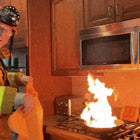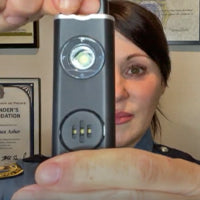Where you put your smoke detectors matters just as much as installing them. Proper placement makes sure they can detect...
Three-prong plugs are common, but that third prong is often overlooked. It might seem like a small part, but it plays a big role in keeping you safe from electrical fires and shocks. So, is using a three-prong plug with a missing ground post safe or unsafe? This guide explains why that third prong matters and provides tips to keep your home safe.
What Is a Three-Prong Plug?

A three-prong plug keeps you safe. In particular, the two flat prongs power your device. One sends electricity in (hot), and the other sends it back out (neutral). The third, rounded prong is the ground. It doesn’t power anything directly, but it’s a safety backup if something inside the device goes wrong.
The ground doesn’t power anything. It’s there to protect you if something inside the device fails. If a wire comes loose or something short-circuits, electricity might try to travel where it shouldn’t, like to the metal casing of an appliance. If you touched it, you could get shocked.
The ground prong gives that stray current a safe way out. It sends the electricity straight to the ground through your home’s wiring system. This trips the circuit breaker and shuts off the power before anything bad happens, like a fire or electric shock.
What Is a Ground Prong?
The ground prong is the round third prong on a three-prong plug. It’s not there to power anything. It’s there to keep you safe. If something goes wrong inside an appliance, like a wire coming loose or a part shorting out, electricity might travel to places it shouldn’t. That’s when the ground prong kicks in.
Instead of that stray current shocking you or damaging the device, the ground prong gives it a safe way out. It directs the electricity into the ground through your home’s wiring, which trips the breaker and shuts everything off before things get worse.
The ground prong is part of a grounding system that connects the device to your electrical panel. It’s a backup safety route for electricity, not part of the regular power flow.
Is It Safe to Use a Three-Prong Plug With a Missing Ground Post?

It’s not safe to use a three-prong plug with a missing ground prong. The third prong is more than just a piece of metal. It’s a safety feature that gives stray electricity a safe path to the ground if something goes wrong. Without the prong, electricity might flow into the appliance’s outer casing if a wire gets loose or other issues occur.
While appliances have safety features, something might fail over time. Removing the ground prong is risky, and your safest bet is to upgrade your two-prong outlets into grounded three-prong ones. If you’re not trained to do this, call an electrician. It will cost more, but it’s worth your safety.
Why It’s Not Safe to Use a Three-Prong Plug With a Missing Ground Post

Using a plug with the ground prong missing might look harmless, but it’s actually a huge safety risk. Without it, you’re more likely to get shocked, face a fire, and more. Here are the top reasons why it’s not safe to use a three-prong plug with a missing ground post:
Electric Shock
The ground prong prevents electric shocks. It gives electricity a safe way out if something goes wrong inside the equipment. Without it, stray electrical current can build up and make metal parts go live. Once you touch the appliance or device, that current could run through you instead. It’s painful and could be deadly, especially with bigger appliances or faulty wiring.
Electric Fires
Heat buildup is more likely to occur when a plug isn’t grounded. The heat can damage wires, melt insulation, and start a fire. Grounding redirects that energy before it causes problems. Without the third prong, your home is more vulnerable to electrical fires.
It also helps to keep a fire blanket, fire spray, and flame shield within reach. They’re easy to use and can stop small fires before they get worse. Toss the blanket over flames or spray directly at the source; no fancy training needed.
Appliance Damage
Grounding doesn’t just protect you and your family. It also helps protect your appliances and devices. If a fault happens and there’s no ground, the extra current can damage sensitive internal components. You might not notice it at first, but the damages add up over time. As a result, your electronics could fail or need expensive repairs.
Code Violations
Most modern building codes require grounded outlets and plugs. If you’re using a broken or altered plug, you’re likely not following the code. That could cause issues during home inspections or insurance claims. In some cases, damage caused by ungrounded plugs might not be covered by your insurance.
Can a Missing Ground Prong Cause a Fire?

Yes, a missing ground prong can cause a fire. That third prong is there to safely carry away excess electrical current if something goes wrong inside the device. Without it, extra electricity has nowhere to go and can cause the wiring to overheat. It gets worse when cords are damaged, especially from wear and tear, pulling them out wrong, or pinching them under heavy furniture.
Frayed or exposed wires can spark or overheat, especially if the ground connection is missing. This could easily lead to a short circuit or fire, especially with appliances that move around a lot, like vacuums or power tools. If you see a plug with a broken ground prong or a cord that’s worn out, don’t ignore it. Unplug the appliance and replace the cord. It’s a small fix that can prevent a serious fire risk.
What Happens if the Ground Prong Is Missing?
A missing ground prong means a safety feature is gone. The third prong isn’t just a piece of metal. It gives electricity a safe path when something goes wrong. Without it, the hot wires touch the metal casing inside your appliance or device. As a result, the electric current could flow on you instead.
This puts people at the risk of electrocution, burns, and fires. It gets worse if the wires are old or damaged, which makes the appliance or device unsafe to touch. While some people think it’s safe to remove the prong, that’s not safe. The appliance or device might still work, but the extra protection is gone. So, always replace a broken plug and don’t ignore missing prongs. It’s never worth the risk.
Can You Remove the Ground Prong?
No, you shouldn’t remove the ground prong. It’s there to protect you and your family from risks such as electric shocks and fires. Plus, removing the ground prong violates electrical codes and damages your appliances. Instead, use GFCI (Ground-Fault Circuit-Interrupters) outlets or the right adapter.
Electrical Safety Tips

Using a three-prong plug without the ground prong is risky. It’s easy to overlook, but missing it can cause huge problems. Here are some safety tips to protect you and keep your electrical setup in great shape:
1. Inspect Your Plugs and Outlets Regularly
Regularly inspect our plugs and outlets. If you see a missing ground prong on a three-prong plug, don’t use it until it’s replaced. You should also check if your outlets can handle three-prong plugs to avoid electrical issues.
2. Replace Damaged Plugs
The safest move is to replace a ground prong (or any prong for that matter). You can ask an electrician to fix the damaged plug and check it for extra safety. Using certified electric parts and consulting an electrician makes sure you and your loved ones stay safe.
3. Avoid Relying on Adapters
Adapters might seem like a quick fix to use a three-prong plug with a missing ground, but they aren’t safe long-term. They bypass the grounding safety feature, increasing the chance of shocks or fires.
4. Upgrade Your Electrical System
If your home still has older two-prong outlets, consider upgrading to modern three-prong or GFCI outlets. This improves safety for all your devices and protects your family from electrical hazards.
GFCIs quickly cut power if they detect a fault. Installing these in kitchens, bathrooms, attached garages, and damp areas adds a layer of protection, especially if your outlets aren’t grounded properly.
5. Consult a Licensed Electrician
When in doubt, call a professional. An electrician can check your wiring, find hidden risks, and suggest the safest fixes. Regular inspections and expert advice help keep your home’s electrical system in good shape.
6. Educate Yourself and Your Family
Understanding electrical safety is key. Make sure everyone knows why grounding matters and how to spot damaged plugs or outlets. Being informed also helps prevent accidents and keeps your home safer.
7. Use Surge Protectors
Surge protectors help guard your devices against power surges from storms or faulty wiring. They don’t replace grounding but add extra protection to your electronics.
Conclusion
Using a three-prong plug without the ground prong isn’t safe. That little third prong protects you from shocks and fires by giving electricity a safe way out if something goes wrong. If you notice a missing ground prong, replace the plug or get a professional to help. It’s a small step that makes a big difference for your safety.
Do you want reliable, easy-to-use, and affordable tools to put out small electric fires before they spread? Check out Prepared Hero’s fire prevention tools here, and get up to 51% off on certain items. Stay prepared, hero!


 Fire
Fire Safety
Safety Survival
Survival Protection
Protection New
New Scouting America
Scouting America
 Fire
Fire Safety
Safety Survival
Survival Protection
Protection New
New












